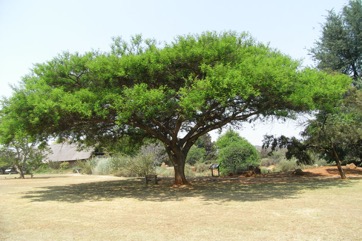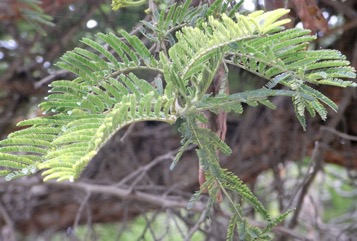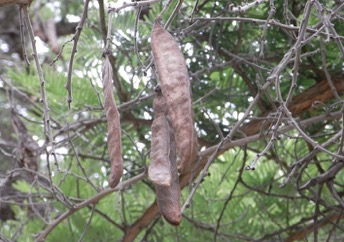Paperbark acacia, Flat-topped thorn

It is a tropical plant. It occurs in semi arid areas. It grows in the Sahel. In Uganda is grows between 600-2,800 m altitude. It is sensitive to frost when young. It is fairly drought tolerant. It grows in areas with an annual rainfall above 300 mm. It can grow in arid places.
Also known as:
Achara, Asa, Asaro, Conga, Etirir, Etirok, Gunga, Maronga, Minganzolo, Morumosetlha, Munga kuu, Mutiti, Muwawa, Muyanya, Mwera, Nthonkoryo, Papierbasdoring
Synonyms
- Acacia amboensis Schinz
- Acacia nefasia (Hochst. ex A. Rich) Schweinf. var. vermoesenii Keay & Brenan
- Acacia purpurascens Vatke
- Acacia sieberana DC
- Acacia vermoesenii De Willd.
- Acacia sieberana DC subsp. vermoesenii (De Wild.) Troupin
- Inga nefasia Hochst. ex A. Rich.
- Prosopis dubia Guill. et Perrott.
Edible Portion
- Gum, Vegetable
Where does Paperbark acacia grow?
Found in: Africa, Angola, Benin, Botswana, Burkina Faso, Cameroon, Central Africa, Chad, Congo, Côte d'Ivoire, East Africa, Eritrea, Eswatini, Ethiopia, Gambia, Ghana, Guinea, Guinée, Guinea-Bissau, India, Ivory Coast, Kenya, Liberia, Malawi, Mali, Mauritania, Mozambique, Namibia, Niger, Nigeria, Pakistan, Portugal, Rwanda, Sahel, Senegal, Sierra Leone, South Africa, Southern Africa, Sudan, Swaziland, Tanzania, Togo, Uganda, West Africa, Zambia, Zimbabwe
Notes: There are about 1,350 Acacia species. Over 1,000 occur in Australia. Also as Mimosaceae.
Status: It is mainly eaten by children.
Growing Paperbark acacia, Flat-topped thorn
Cultivation: It is grown from seed. The seed should be put in hot water then allowed to cool and soak for 24 hours before sowing. The seed can be stored if kept cool, dry and insect free. The tree can be pruned or cut back and allowed to re-grow. Seeds can be stored if cool and dry.
Edible Uses: The gum is eaten raw.
Production: The tree is slow growing.
Nutrition Info
per 100g edible portion| Edible Part | Energy (kcal) | Protein (g) | Iron (mg) | Vitamin A (ug) | Vitamin c (mg) | Zinc (mg) | % Water |
|---|---|---|---|---|---|---|---|
| Leaves | 30 | 1.8 | 3.7 | 945 | 19 | - | 91 |
| Gum | - | - | - | - | - | - | |
| Leaves | - | - | - | - | - | - | |
| Flowers | - | - | - | - | - | - |
Paperbark acacia, Flat-topped thorn Photos



References
Addis, G., et al, 2005, Ethnobotanical Study of Edible Wild Plants in Some Selected Districts of Ethiopia. Human Ecology, Vol. 33, No. 1, pp. 83-118
Agroforestree Database. World Agroforestry Centre
Ambasta S.P. (Ed.), 2000, The Useful Plants of India. CSIR India. p 7
Bekele-Tesemma A., Birnie, A., & Tengnas, B., 1993, Useful Trees and Shrubs for Ethiopia. Regional Soil Conservation Unit. Technical Handbook No 5. p 66
Bunderson, W. T. et al, 2002, Common Agroforestry Species in Malawi. Malawi Agroforestry Extension Project, Pubication No. 46, Lilongwe. p 14
Chapman, J. D. & Chapman, H. M., 2001, The Forest Flora of Taraba and Andamawa States, Nigeria. WWF & University of Canterbury. p 183
Choudhary, S., 1999, Ethnobotany of Janjangbureh Island, The Gambia, West Africa. Honors thesis Dept. Biology City University of New York.
Dharani, N., 2002, Field Guide to common Trees & Shrubs of East Africa. Struik. p 36
Drummond, R. B., 1981, Common Trees of the Central Watershed Woodlands of Zimbabwe, National Herbarium Salisbury. p 54
Fowler, D. G., 2007, Zambian Plants: Their Vernacular Names and Uses. Kew. p 33
Gallagher, D. E., 2010, Farming beyond the escarpment: Society, Environment, and Mobility in Precolonial Southeastern Burkina Faso. PhD University of Michigan
Grubben, G. J. H. and Denton, O. A. (eds), 2004, Plant Resources of Tropical Africa 2. Vegetables. PROTA, Wageningen, Netherlands. p 559
Harris, F. M. A. and Mohammed, S., 2003, Relying on Nature: Wild Foods in Northern Nigeria. Ambio Vol. 32 No. 1. p 25-30
ILDIS Legumes of the World http:www;ildis.org/Legume/Web
Joffe, P., 2007, Creative Gardening with Indigenous Plants. A South African Guide. Briza. p 133
Katende, A.B., Birnie, A & Tengnas B., 1995, Useful Trees and Shrubs for Uganda. Identification, Propagation and Management for Agricultural and Pastoral Communities. Technical handbook No 10. Regional Soil Conservation Unit, Nairobi, Kenya. p 58
Maydell, H. von, 1990 Trees and shrubs of the Sahel: their characteristics and uses. Margraf. p 141
Palgrave, K.C., 1996, Trees of Southern Africa. Struik Publishers. p 251
Palmer, E and Pitman, N., 1972, Trees of Southern Africa. Vol. 2. A.A. Balkema, Cape Town p 700
Prodr. 2:463. 1825
Roodt, V., 1998, Trees & Shrubs of the Okavango Delta. Medicinal Uses and Nutritional value. The Shell Field Guide Series: Part 1. Shell Botswana. p 195
Royal Botanic Gardens, Kew (1999). Survey of Economic Plants for Arid and Semi-Arid Lands (SEPASAL) database. Published on the Internet; http://www.rbgkew.org.uk/ceb/sepasal/internet [Accessed 27th April 2011] (As Acacia sieberiana var. woodii)
Ruiters-Welcome, A. K., 2019, Food plants of southern Africa. Ph.D. thesis. Univ. of Johannesburg p 62
Storrs, A. E. C., 1995 reprint, Know Your Trees. Some Common Trees found in Zambia, Forestry Division. p 47
van Wyk, B, van Wyk, P, and van Wyk B., 2000, Photographic guide to Trees of Southern Africa. Briza. p 43
van Wyk, Ben-Erik, 2019, The diversity and multiple uses of southern African legumes. Australian Systematic Botany, 2019, 32, 519–546
Venter, F & J., 2009, Making the most of Indigenous Trees. Briza. p 30
www.worldagroforestrycentre.org/sea/products/afdbases/af/asp